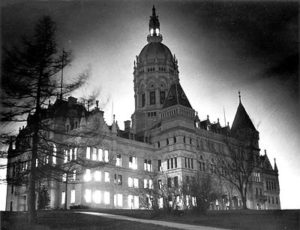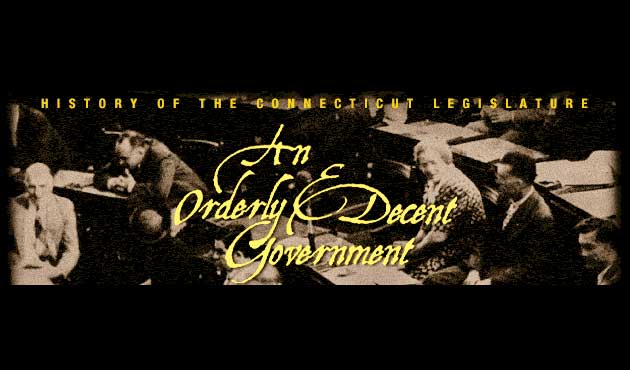The New Deal
Immediately upon taking office in 1932, President Roosevelt began the New Deal, a package of programs aimed at relieving the misery of the Great Depression. Connecticut officials initially spurned all offers of assistance, but by 1933 the legislature created an Emergency Relief Commission to apply for federal support.

Blackout test at the Capitol, December 12, 1941
Wilbur Cross entered office in 1930 a fiscal conservative but finally recognized the need for a more active state role in helping the destitute. He submitted a “Little New Deal” to the legislature in his second term. New programs assisted the elderly, modernized state hospitals, prisons and universities, and provided jobs for the unemployed. During his tenure, the General Assembly eliminated sweatshops, outlawed the employment of minors under 16, limited the work-week for women and children and passed programs of unemployment insurance and old age pensions.
Lights ablaze and dark curtains ready, the State Capitol begins a black-out test on December 12, 1941, five days after the attack on Pearl Harbor. During the War the General Assembly granted the governor broad powers to handle war-time emergencies.
The Era of John Bailey

John Moran Bailey
In the 1950s Connecticut rapidly became a suburban state. Between 1945 and 1960 Hartford, New Haven, and Bridgeport lost population, while suburbs like Bloomfield, Woodbridge, and Trumbull more than doubled. The legislature aided homeowners-to-be with a $60 million mortgage program offering 1.5% financing.
Tightly controlling party affairs for over 30 years, John Bailey assembled a classic Democratic coalition of ethnic voters, labor, intellectuals and the poor that regularly returned Democrats to office. In Abraham Ribicoff (1955-61), John Dempsey (1961-71), and Ella Grasso (1975-80), Bailey offered this coalition gubernatorial candidates who were socially progressive but fiscally cautious.
Bailey controlled the General Assembly’s agenda with an iron hand. In the 1959 session, Democrats held a majority in both houses for the first time since 1876, although only by three votes in the House. Party discipline was crucial to Democratic success, and John Bailey delivered it.
“All you needed to know was that John Bailey was it.”
– Bob Conrad, political columnist,
Hartford Times
This article is a panel reproduction from An Orderly and Decent Government, an exhibition on the history of representative government in Connecticut developed by Connecticut Humanities and put on display in the Capitol concourse of the Legislative Office Building, Hartford, Connecticut.
<< Previous – Home – Next >>









